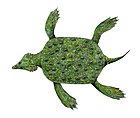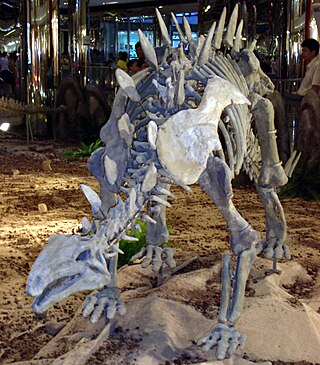
Huayangosaurus is a genus of stegosaurian dinosaur from the Middle Jurassic of China. The name derives from "Huayang" (華陽), an alternate name for Sichuan, and "saurus", meaning "lizard". It lived during the Bathonian to Callovian stages, around 165 million years ago, some 20 million years before its famous relative, Stegosaurus appeared in North America. At only approximately 4 metres (13 ft) long, it was also much smaller than its famous cousin. Found in the Lower Shaximiao Formation, Huayangosaurus shared the local Middle Jurassic landscape with the sauropods Shunosaurus, Datousaurus, Omeisaurus and Protognathosaurus, the ornithopod Xiaosaurus and the carnivorous Gasosaurus.
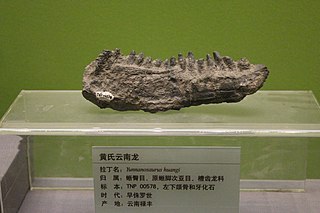
Yunnanosaurus is an extinct genus of sauropodomorph dinosaur that lived approximately 199 to 183 million years ago in what is now the Yunnan Province, in China, for which it was named. Yunnanosaurus was a large sized, moderately-built, ground-dwelling, quadrupedal herbivore, that could also walk bipedally, and ranged in size from 7 meters (23 feet) long and 2 m (6.5 ft) high to 4 m (13 ft) high in the largest species.

Macrocnemus is an extinct genus of archosauromorph reptile known from the Middle Triassic of Europe and China. Macrocnemus is a member of the Tanystropheidae family and includes three species. Macrocnemus bassanii, the first species to be named and described, is known from the Besano Formation and adjacent paleontological sites in the Italian and Swiss Alps. Macrocnemus fuyuanensis, on the other hand, is known from the Zhuganpo Formation in southern China. A third species, Macrocnemus obristi, is known from the Prosanto Formation of Switzerland and is characterized by gracile limbs. The name Macrocnemus is Greek for "long tibia".
Dactylosaurus is a genus of nothosaur in the family Pachypleurosauridae. Along with Anarosaurus, Dactylosaurus was one of the earliest known pachypleurosaurs to come from Europe.
Chinchenia is an extinct genus of a basal pistosauroid known from the Middle Triassic of Guizhou Province, southwestern China. It contains a single species, Chinchenia sungi.
Fenhosuchus is an extinct genus of archosauriform. The holotype, IVPP V 2697, and referred materials have been found in the Hsishihwa locality at Wuhsiang, China, from the Upper Ermaying Formation. The locality dates back to the Anisian stage of the Middle Triassic. The genus was named after the Fen River in Shanxi Province from which specimens were found. It may prove to be a chimera being composed of material from several different animals. Some material were believed to represent a rauisuchid. The calcaneum of Fenhosuchus seems to belong to an erythrosuchid or other basal archosauriform. Much of the material of the tarsal bones seem to be similar to those of the genus Shansisuchus. According to Nesbitt (2009) the assessment of Gower (2000) was correct, the holotype is a mix of Shansisuchus remains and a possible fragment from a paracrocodylomorph or a dinosauriform. Thus, Fenhosuchus cannot be considered a rauisuchian.

Sinosaurosphargis is an extinct genus of basal marine saurosphargid reptile known from the Middle Triassic Guanling Formation of Yunnan and Guizhou Provinces, southwestern China. It contains a single species, Sinosaurosphargis yunguiensis.
Diandongosaurus is an extinct genus of eosauropterygian known from the lower Middle Triassic of Yunnan Province, southwestern China. It is known from the holotype IVPP V 17761, a complete and articulated skeleton with skull, which was found in the middle Triassic Lagerstätte of the Guanling Formation. It was first named by Qing-Hua Shang, Xiao-Chun Wu, Chun Li in 2011 and the type species is Diandongosaurus acutidentatus. A referred specimen suggests a total body length of 34 cm (13 in).
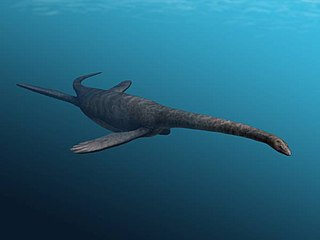
Yunguisaurus is an extinct genus of pistosaur known from the Guizhou Province of China.
Largocephalosaurus is an extinct genus of basal saurosphargid, a marine reptile known from the Middle Triassic Guanling Formation of Yunnan and Guizhou Provinces, southwestern China. It contains a type species, Largocephalosaurus polycarpon, and a second species L. qianensis.

Eumetabolodon is an extinct genus of procolophonine procolophonid parareptile from early and middle Triassic deposits of Nei Mongol, northern China. Two species of Eumetabolodon were named by J. L. Li in 1983 and the type species is Eumetabolodon bathycephalus.
Guchengosuchus is an extinct genus of erythrosuchid archosauriform from the Early Triassic of China. It is known from a single holotype skeleton called IVPP V 8808, described in 1991 from the lower Ermaying Formation in Shanxi. The lower Ermaying Formation dates back to the Olenekian stage of the Early Triassic, making Guchengosuchus one of the earliest archosauriforms. IVPP V 8808 is a disarticulated skeleton including a partial skull, lower jaw, some vertebrae, a scapula, and forelimb bones. Like some other erythrosuchids, Guchengosuchus has a tall skull with a notch between the premaxilla and maxilla bones of the upper jaw. The ribs of Guchengosuchus each have three heads, a feature also seen in the Russian erythrosuchid Vjushkovia. When it was first described, Guchengosuchus was placed in the suborder Proterosuchia, a group that included the families Erythrosuchidae, Proterosuchidae, and Proterochampsidae and was thought to be closely related to a primitive group of reptiles called Eosuchia. Proterosuchia is now considered a paraphyletic assemblage of basal archosauriforms representing a series of successive branches of stem group archosaurs.
Qianxisaurus is an extinct genus of pachypleurosaur or alternatively a basal eosauropterygian known from the Middle Triassic of Guizhou Province, southwestern China. It contains a single species, Qianxisaurus chajiangensis.
Xinminosaurus is an extinct genus of cymbospondylid ichthyosaur known from the Middle Triassic of Guizhou Province, China.
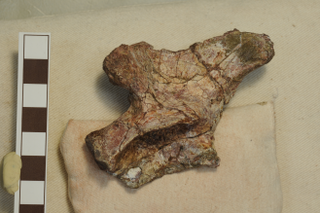
Lutungutali is an extinct genus of silesaurid dinosauriform from the Middle Triassic of Zambia. The single type species of the genus is Lutungutali sitwensis. Lutungutali was named in 2013 and described from a fossil specimen, holotype NHCC LB32, including hip bones and tail vertebrae. The specimen was collected in 2009 from the upper Ntawere Formation, which dates to the Anisian stage of the Middle Triassic. Lutungutali is the first known silesaurid from Zambia and, along with the Tanzanian silesaurid Asilisaurus and dinosauriform Nyasasaurus, the oldest bird-line archosaur known from body fossils.
Majiashanosaurus is an extinct genus of pachypleurosaur or alternatively a basal eosauropterygian known from the Early Triassic of Anhui Province, eastern China. It contains a single species, Majiashanosaurus discocoracoidis.
Sanchiaosaurus is an extinct genus of a basal nothosauroid known from the Middle Triassic of Guizhou Province, southwestern China. It contains a single species, Sanchiaosaurus dengi.

Saurosphargidae is an extinct family of marine reptiles known from the Early Triassic and early Middle Triassic of Europe and China.
Saurosphargis is an extinct genus of a basal marine reptile, saurosphargid, known from the Middle Triassic of southwestern Poland and eastern Netherlands. It contains a single species, Saurosphargis volzi.

Pectodens is an extinct genus of archosauromorph reptile which lived during the Middle Triassic in China. The type and only species of the genus is P. zhenyuensis, named by Chun Li and colleagues in 2017. It was a member of the Archosauromorpha, specifically part of the unnatural grouping Protorosauria. However, an unusual combination of traits similar and dissimilar to other protorosaurs initially led to confusion over its evolutionary relationships. In 2021, it was placed in a newly-established group, Dinocephalosauridae, along with its closest relative Dinocephalosaurus.








